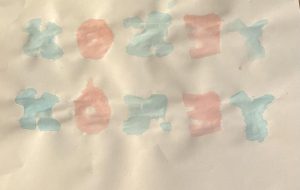“Its intent is not to spy on the inner thoughts of unsuspecting dead people. Rather, it is fueled by the desire to come into contact with interesting people we might not otherwise know if not for the records of their minds they left behind.” Ratner-Rosenhagen (2019)
I chose the word “honey,” and believe my inspiration for this word came to me as I was making my tea with, you guessed it, honey. 
As I was mulling over what word to choose, I pictured the word in my mind, and I could find at least three other words in this one word, can you? The mechanization of cutting the shapes of the letters was a 45 minutes process for me, so it was a slow printing process that Bolter (2001) refers to as “the insistent rhythm of the machine” (p. 15). However, preparing to engage in this task took a lot longer as I had to go and purchase potatoes. Then I watched the video as I have never created potato stamps. I found it challenging to create these block print letters, and I can associate this task with the originator of the press Johannes Gutenberg (c.1397-1468), a German Goldsmith. When it was time for me to carve the letters accurately, I did not consider using the typeface Gutenberg used, which was cursive. Not only would it have been impossible for me to recreate, but it also is not the type of fonts we currently use in teaching and learning.

The process of cutting, sculpting and lining up the letters to ensure it mirrors the first print word on the parchment of paper I chose was super challenging. As you can see, the letters do not appear well defined on paper; therefore, the mechanization requires “considerable technical skill,” as Bolter (2001) notes. Nevertheless, I appreciate the craftsmanship of the Gutenberg press to create cursive typefaces using metal. It makes sense that the originator of the press was a Goldsmith.
My objective was to create large, legible letters using a modern style block letter font. However, I felt that the letters I carved out were slightly bland; hence, I decided to decorate my letters by adding colours. It made me think of how we use text and technology, especially for advertising. It made me think about Marshall McLuhan and Bolter’s thoughts on how our current technology may use modern tools; however, it somehow reinvents its predecessors using font and colours.
The letter “N,” I have to say, was the most challenging levelling, so when placing it on the paper, all areas of the letter touched the paper for a good print. It was one of the trickiest parts of this process for me. Secondly, after carving all the letters, I forgot that certain letters need to be cut out backwards, such as “N” and “E.” Lastly, making sure each letter size was the same proved challenging. It made me think that each word retained the “curious edge when it was first written down” (Lam & McCormick, 2020, 6:24). Therefore, what I was missing was the consistency of the mechanization a printing press would give; however, it is my handmade typeface and its imperfection that highlights my humanity in print with the use of low-level technology.
I can not help but admire the time, skill, and dedication it would have taken the originators of the printed press to create a book. Through mechanization and modern technology, using text is easy for us to record and share information. As Lam and McCormick (2020) observe, communicating using written language was a form of centralized power. So technology and text help the decentralization of knowledge; therefore, the power of the written word has changed the way society currently thinks and will continue to shape the way we share information.
References
Bolter, Jay David. (2001). Writing space: Computers, hypertext, and the remediation of print [2nd edition]. Mahwah, NJ: Lawrence Erlbaum.
Lam R. and McCormick J. (2020). From the Vault: Invention of the Book, Part 1. Retrieved October 4, 2021, from https://www.iheart.com/podcast/stuff-to-blow-your-mind-21123915/episode/from-the-vault-invention-of-the-82316952/.
Ratner-Rosenhagen, J. (2019, March 29). What does it mean to call an idea American? Literary Hub. Retrieved October 4, 2021, from https://lithub.com/what-does-it-mean-to-call-an-idea-american/.